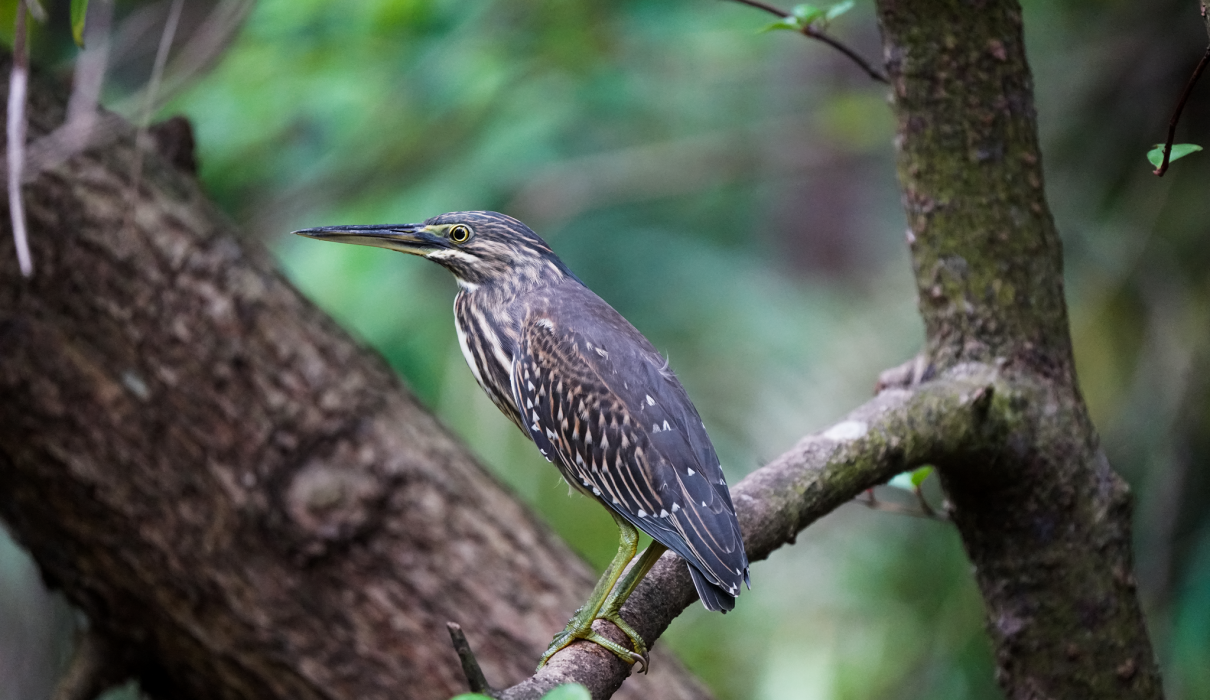Striated Heron (Butorides striata) – Dhivehi Raaboadhi
The Striated Heron, known in Dhivehi as Raaboadhi, is a small, stocky wading bird commonly found across tropical and subtropical regions. With its greyish-green plumage, sharp beak, and relatively short legs compared to other herons, the Striated Heron is well-adapted to its environment, making it a successful predator in both coastal and freshwater habitats. Its stealthy behavior while hunting, often standing still for extended periods, allows it to ambush prey effectively.
Taxonomy and Classification
The Striated Heron belongs to the family Ardeidae, which includes other herons, egrets, and bitterns. Its scientific name is Butorides striata. The genus Butorides refers to small herons that have a squat appearance, and the species striata relates to its streaked (striated) breast pattern. Previously, this bird was sometimes considered a subspecies of the Green Heron (Butorides virescens), but recent genetic and morphological studies have classified it as a separate species. Here is the taxonomic breakdown:
- Kingdom: Animalia
- Phylum: Chordata
- Class: Aves
- Order: Pelecaniformes
- Family: Ardeidae
- Genus: Butorides
- Species: Butorides striata
Distribution and Habitat
The Striated Heron is widely distributed across Asia, Africa, Australia, and the Pacific Islands. It prefers areas with access to water, especially mangroves, estuaries, riverbanks, and coral reefs. Raaboadhi can often be seen in coastal areas where it forages along shallow waters, searching for fish, crabs, and small invertebrates.
This bird is highly adaptable, capable of surviving in a variety of wetland habitats, including both freshwater and saline environments. It is often found around human settlements, particularly near piers, harbors, and lagoons, where fishing opportunities are abundant.
Behavior and Feeding
Striated Herons are primarily solitary birds and are known for their unique hunting technique called “stand-and-wait” fishing. They typically perch motionlessly near water edges, using their excellent vision to spot prey. Once they identify their target, they rapidly thrust their sharp beaks into the water to capture small fish or other aquatic organisms. Their diet mainly consists of fish, amphibians, insects, and occasionally small crustaceans.
Interestingly, some populations of Striated Herons have been observed using tools to catch prey. They may drop bait, such as insects or leaves, onto the surface of the water to lure fish, showcasing an advanced form of problem-solving behavior rarely seen in birds.
Breeding and Nesting
The breeding season of the Striated Heron varies depending on location, but it usually coincides with the rainy season when food is abundant. In the Maldives, Raaboadhi builds nests in mangroves or dense shrubs, where they lay a clutch of 2 to 5 pale blue-green eggs. Both parents participate in incubation, which lasts about 20 to 25 days. After hatching, the chicks remain in the nest for another few weeks, during which they are fed by both parents.
The nesting behavior of Striated Herons is similar to that of other herons, where they create simple platform nests made from twigs, leaves, and other plant materials. The nests are usually located in trees or bushes near water, providing safety from predators and easy access to food.
Conservation Status
The Striated Heron is currently listed as a species of Least Concern by the International Union for Conservation of Nature (IUCN). Its widespread distribution and adaptability to different habitats have allowed it to maintain stable population numbers across most of its range. However, like many water-dependent species, the Striated Heron faces threats from habitat loss due to coastal development, pollution, and climate change.
In the Maldives, efforts to protect coastal ecosystems, such as mangroves and coral reefs, are crucial for the conservation of species like Raaboadhi, as these environments provide essential feeding and breeding grounds for the bird.
Cultural Significance
In the Maldives, the Striated Heron holds a place in local culture as part of the rich coastal biodiversity. Its name, Raaboadhi, is familiar to coastal communities who often observe its quiet, solitary presence. Although it does not have significant symbolic or mythological importance, its role in controlling fish and insect populations contributes to the ecological balance in the region.
For some Maldivians, herons hold a more personal significance. In childhood, Maldivians like myself had the opportunity to care for the Striated Heron, Maldivian Pond Heron (Ardeola grayii), and Gray Heron (Ardea cinerea) as pets. These experiences foster a deep connection to the bird and local wildlife, further contributing to an understanding of their behaviors and importance in the ecosystem.
Morphology and Identification
The Striated Heron is a relatively small heron, typically measuring about 40 to 46 cm in length, with a wingspan of approximately 60 to 70 cm. Its plumage is primarily bluish-grey with darker streaks on its chest, and it has a distinctive black crown on its head. The eyes are yellow or orange, giving the bird sharp vision suited for spotting prey in shallow waters.
Juvenile Striated Herons are browner with more streaking on their underparts compared to adults, making them less colorful but still easily recognizable by their compact size and behavior. Their legs are short and yellowish-green, aiding them in walking through shallow water while hunting.
Vocalization
The Striated Heron is relatively quiet compared to other heron species. Its calls are low-pitched and croaking, often heard during flight or when alarmed. The typical sound is a short “skew” or “kyow” call, used to communicate with other herons, particularly during breeding or territorial disputes.
Conclusion
The Striated Heron (Butorides striata) or Dhivehi Raaboadhi is a remarkable bird with fascinating behaviors and ecological significance in the Maldives. Its adaptability and intelligence, particularly in its unique hunting techniques, make it a key species in coastal environments. Though its conservation status is stable, ongoing efforts to protect its natural habitats will ensure that this iconic bird continues to thrive in the Maldives and other regions.
References
- International Union for Conservation of Nature (IUCN) Red List. Striated Heron (Butorides striata). IUCN Red List.
- Birds of the World. Striated Heron (Butorides striata). Cornell Lab of Ornithology.
- Handbook of the Birds of the World. Herons (Ardeidae). HBW Alive.
- BirdLife International. Striated Heron distribution and behavior. BirdLife International.
- The Maldives Coastal Ecosystem. Striated Heron in the Maldives. Maldives Biodiversity Database.


